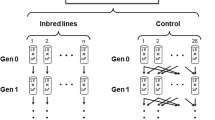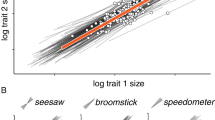Abstract
A COMMON feature of many selection experiments, when polygenically determined traits are involved, is a reduction in the reproductive fitness of the selected strains. Experimental selection for differences in the numbers of abdominal bristles and sternopleural chaetae in Drosophila melanogaster produced sterility and a reduction in fertility in the selected strains1,2. Latter3 found that the “competitive index” (mating propensity, female fecundity and survival ability) had fallen sharply in strains of D. melanogaster subjected to experimental selection for differences in scutellar bristle number. Selection in Tribolium for change in developmental rates produced alterations in productivity, body size and viability of the flour beetles4. The reproductive fitness of chickens under selection for increased shank length was reduced steadily throughout the selection process5.
This is a preview of subscription content, access via your institution
Access options
Subscribe to this journal
Receive 51 print issues and online access
$199.00 per year
only $3.90 per issue
Buy this article
- Purchase on Springer Link
- Instant access to full article PDF
Prices may be subject to local taxes which are calculated during checkout
Similar content being viewed by others
References
Mather, K., and Harrison, B. J., Heredity, 3, 1–52, and 131–162 (1949).
Wigan, L. G., and Mather, K., Ann. Eugen., 11, 354–364 (1942).
Latter, B. D. H., Genet. Res., 8, 205–218 (1966).
Dawson, P. S., Genetics, 37, 63–77 (1966).
Lerner, I. M., and Dempster, E. R., Heredity, 5, 75–94 (1951).
Lerner, I. M., Genetic Homeostasis (Wiley, New York, 1954).
Dobzhansky, T., and Spassky, B., Proc. natn. Acad. Sci. U.S.A., 48, 1704–1712 (1962); 62, 75–80 (1969).
Watanabe, T. K., and Anderson, W. W., Behav. Genet., 6, 71–86 (1976).
Hirsch, J., J. comp. Physiol. Psychol., 52, 304–308 (1959).
Hadler, N. M., Biol. Bull., 126, 264–273 (1964).
Novitski, E., and Rush, G., Drosophila Inf. Serv., 22: 75–76 (1948).
Latter, B. D. H., and Robertson, A., Genet. Res., 3, 110–138 (1962).
King, H. D., J. exp. Zool., 26, 335–378 (1918).
Author information
Authors and Affiliations
Rights and permissions
About this article
Cite this article
PYLE, D. Effects of artificial selection on reproductive fitness in Drosophila. Nature 263, 317–319 (1976). https://doi.org/10.1038/263317a0
Received:
Accepted:
Issue Date:
DOI: https://doi.org/10.1038/263317a0
This article is cited by
-
Mdg-1 mobile element polymorphism in selected Drosophila melanogaster populations
Genetica (1988)
-
Genetic basis of aristal morphology inDrosophila melanogaster and its correlation with behavior: Selection for increased and decreased aristal branching
Behavior Genetics (1979)
-
Repeated mating by femaleDrosophila melanogaster: The adaptive importance
Experientia (1978)
Comments
By submitting a comment you agree to abide by our Terms and Community Guidelines. If you find something abusive or that does not comply with our terms or guidelines please flag it as inappropriate.



